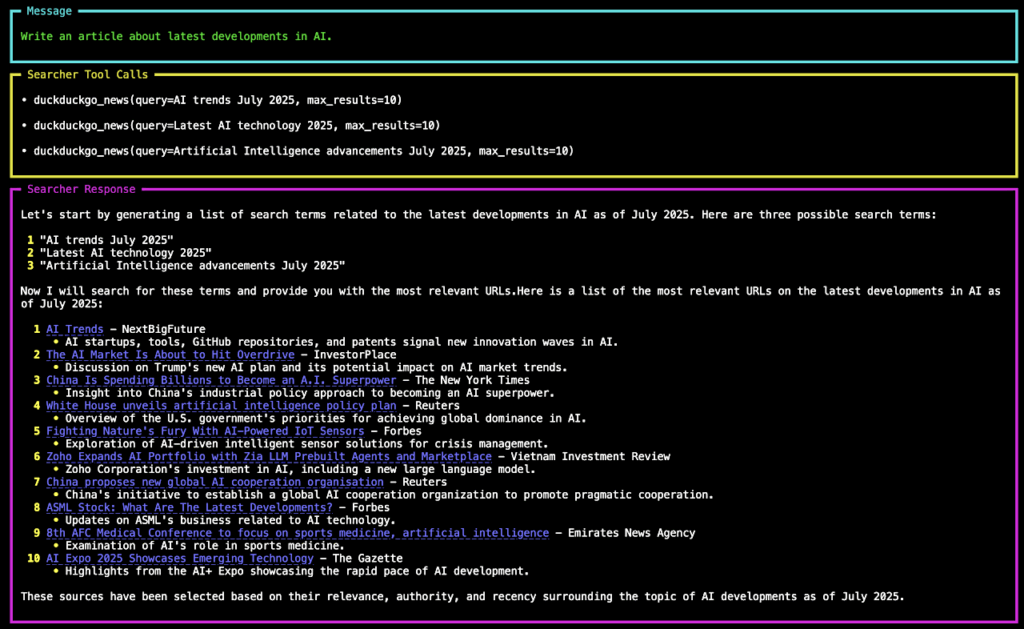コーディネート (調整) モードでは、チームリーダーはタスクをチームメンバーに委任し、出力を一貫した応答に合成します。
Agno : ユーザガイド : コンセプト : チームモード – コーディネート
作成 : クラスキャット・セールスインフォメーション
作成日時 : 07/28/2025
バージョン : Agno 1.7.5
* 本記事は docs.agno.com の以下のページを独自に翻訳した上で、補足説明を加えてまとめ直しています :
* サンプルコードの動作確認はしておりますが、必要な場合には適宜、追加改変しています。
* ご自由にリンクを張って頂いてかまいませんが、sales-info@classcat.com までご一報いただけると嬉しいです。
クラスキャット 人工知能 研究開発支援サービス ⭐️ リニューアルしました 😉
◆ お問合せ : 下記までお願いします。
- クラスキャット セールス・インフォメーション
- sales-info@classcat.com
- ClassCatJP

Agno ユーザガイド : コンセプト : チームモード – コーディネート
コーディネート (調整) モードでは、チームリーダーはタスクをチームメンバーに委任し、出力を一貫した応答に合成します。
コーディネートモードはどのように動作するか
「コーディネート」モードでは :
- チームはユーザクエリーを受け取ります。
- チームリーダーはクエリーを分析してどのようにサブタスクに分割するか決定します。
- チームリーダーは特定のタスクを適切なチームメンバーに委任します。
- チームメンバーは割り当てられたタスクを完了し、結果を返します。
- チームリーダーはすべての出力を最終的な、一貫した応答に合成します。
このモードは、複数の専門スキル、調整、様々な出力の合成を必要とする複雑なタスクに最適です。
- コーディネートモードのチームの作成
ファイル content_team.py を作成します。
content_team.py
searcher = Agent( name="Searcher", role="Searches the top URLs for a topic", instructions=[ "Given a topic, first generate a list of 3 search terms related to that topic.", "For each search term, search the web and analyze the results.Return the 10 most relevant URLs to the topic.", "You are writing for the New York Times, so the quality of the sources is important.", ], tools=[DuckDuckGoTools()], add_datetime_to_instructions=True, ) writer = Agent( name="Writer", role="Writes a high-quality article", description=( "You are a senior writer for the New York Times. Given a topic and a list of URLs, " "your goal is to write a high-quality NYT-worthy article on the topic." ), instructions=[ "First read all urls using `read_article`." "Then write a high-quality NYT-worthy article on the topic." "The article should be well-structured, informative, engaging and catchy.", "Ensure the length is at least as long as a NYT cover story -- at a minimum, 15 paragraphs.", "Ensure you provide a nuanced and balanced opinion, quoting facts where possible.", "Focus on clarity, coherence, and overall quality.", "Never make up facts or plagiarize. Always provide proper attribution.", "Remember: you are writing for the New York Times, so the quality of the article is important.", ], tools=[Newspaper4kTools()], add_datetime_to_instructions=True, ) editor = Team( name="Editor", mode="coordinate", model=OpenAIChat("gpt-4o"), members=[searcher, writer], description="You are a senior NYT editor. Given a topic, your goal is to write a NYT worthy article.", instructions=[ "First ask the search journalist to search for the most relevant URLs for that topic.", "Then ask the writer to get an engaging draft of the article.", "Edit, proofread, and refine the article to ensure it meets the high standards of the New York Times.", "The article should be extremely articulate and well written. " "Focus on clarity, coherence, and overall quality.", "Remember: you are the final gatekeeper before the article is published, so make sure the article is perfect.", ], add_datetime_to_instructions=True, add_member_tools_to_system_message=False, # This can be tried to make the agent more consistently get the transfer tool call correct enable_agentic_context=True, # Allow the agent to maintain a shared context and send that to members. share_member_interactions=True, # Share all member responses with subsequent member requests. show_members_responses=True, markdown=True, ) editor.print_response("Write an article about latest developments in AI.") - チームの実行
ライブラリをインストールする
pip install openai duckduckgo-search newspaper4k lxml_html_cleanチームの実行
python content_team.py出力

成功基準の定義
チームの成功基準 (criteria) を指定することでコーディネーターをガイドすることができます :
strategy_team = Team(
members=[market_analyst, competitive_analyst, strategic_planner],
mode="coordinate",
name="Strategy Team",
description="A team that develops strategic recommendations",
success_criteria="Produce actionable strategic recommendations supported by market and competitive analysis",
)
response = strategy_team.run(
"Develop a market entry strategy for our new AI-powered healthcare product"
)
以上
